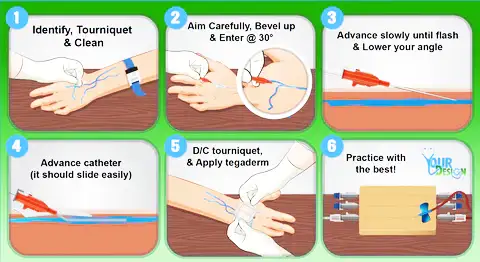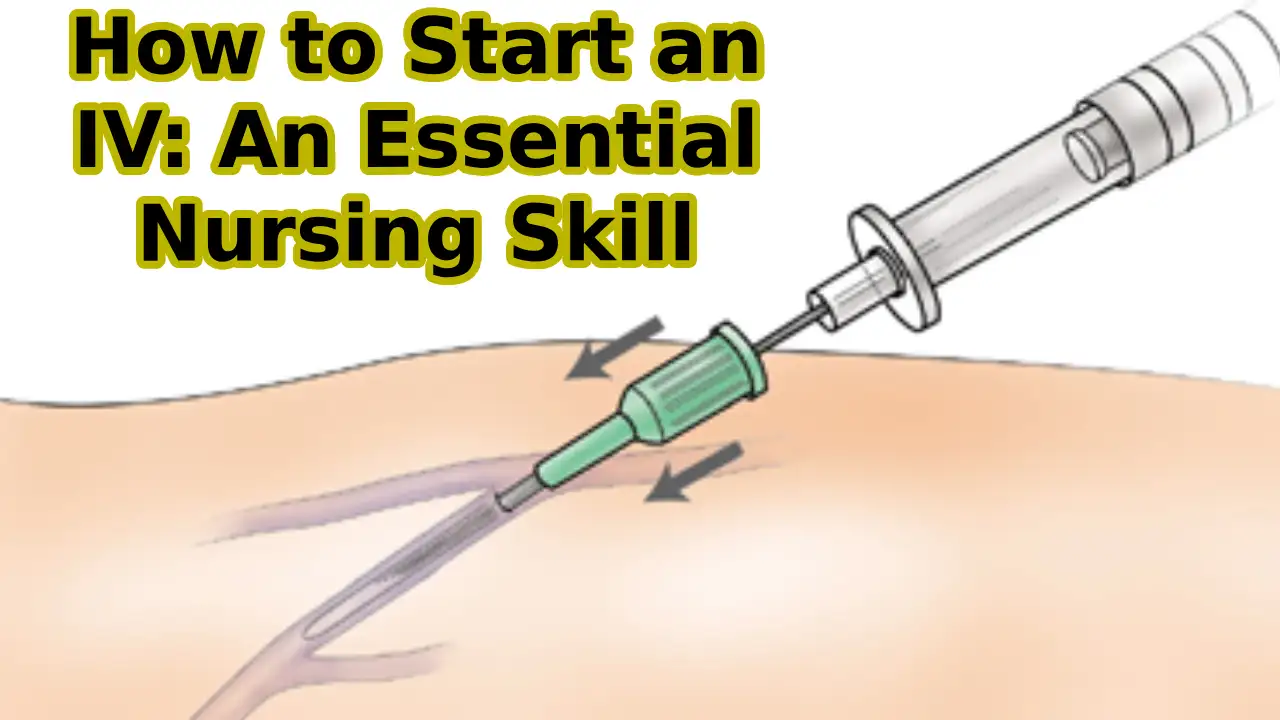How to Start an IV (Intravenous Cannulation): Intravenous insertion is a basic skill that a nurse learns during training. However, it could be difficult to master if you don’t have enough practice and confidence to do it.
Intravenous Cannulation (IV) lines are used to administer fluids, medications, and blood products. Therefore, learning this skill is vital for nurses to provide patient care. If you are a beginner in nursing, you will need to learn how to start an IV. Let’s get started.
What is an IV (Intravenous Cannulation)?
An IV (Intravenous Cannulation) is a small plastic tube inserted into a vein, usually in your hand or arm. An IV technique administers fluids into the bloodstream through a vein when you are dehydrated or can’t drink.
What are IV Fluids?
IV fluids are liquids injected into an individual’s veins through an IV cannula. It helps prevent or treat dehydration and electrolyte imbalances.
When to Start an IV Fluid?
Most facilities require an IV when the patient is admitted. However, the patient may refuse it. Usually, an IV fluid is administered when a person becomes dangerously dehydrated or can’t drink. this technique administers fluids into the bloodstream through a vein
When Not to Start an IV Fluid?
There are no direct contraindications to placing an IV, but some factors will exclude certain locations. These are:
- It would help if you do not start an IV in dialysis patients as they may have AV fistulas or grafts.
- It would help if you do not start an IV in the same arm as a patient with active DVT.
- Do not use IV for infections such as cellulitis because it can introduce bacteria into the blood and lead to sepsis.
What Equipment to Start an IV?
Before learning How to Start an IV, you need first to know which equipment you will require. For an IV insertion, you will need the following equipment.
01. IV Insertion Kits: This kit contains the basic items you will require to insert the IV into the patient’s vein. This kit includes:
- Chlorhexidine or Alcohol Swab
- 2×2 Gauze
- Tape
- Tourniquet
- Tegaderm Dressing
02. IV Needle: It allows you to access your patient’s vein. You use this needle to insert the cannula into the vein and then remove the needle.
03. IV Catheter: You will need an IV catheter, usually 18 to 22 grams.
04. Vacutainer: If you are planning on drawing blood directly, a blood transfer device will be needed.
05. Extension Loop or Cap: You will be required to place an IC cap onto the IV after insertion.
06. Saline Flush: You need one or two saline flushes. Once you’re sure you have all of these equipments, you are ready to start IV.
How to Start an IV (Intravenous Cannulation)?

If you are a beginner in nursing and want to learn How to Start an IV, you can read the following procedures. IV cannulation is an essential skill for nurses, so you should master it to provide patient care.
01. Prepare the Patient to Start an IV
You will first wash your hands before starting an IV. Now put on a pair of clean gloves because you will be interacting with the patient’s blood. Now place the tourniquet on the patient’s arm and look for the straight, large veins. Once you find the vein, use a chlorhexidine (CHG) or alcohol swab to clean the surrounding area for 30 seconds, and wait until it dry.
02. Prepare IV Kit
Open up your IV, take off the needle cap, twist the end of the catheter, and make sure it is loose and ready for cannulation.
03. Keep the Skin Taut While You Start an IV
Hold the patient’s skin tightly with your non-dominated hand to secure the vein stabilize it from rolling, and smooth the skin for IV insertion.
04. Insert the Needle
Insert the needle and bevel up about 30 degrees. If done correctly, you will notice a flashback of blood in the catheter. Progress the entire cannula a further 2mm, fix the needle, and advance the rest of the cannula into the vein. If done correctly, the catheter will slide easily into the vein.
05. Release the Tournique
Now release the tourniquet, pressure to the vein at the tip of the cannula, and remove the needle. Remove the cap from the needle and put this on the back of the cannula. Apply the dressing to the cannula to secure it and make sure that the date sticker has been applied.
06. Fill the Syringe with Saline
Check the date on the saline, if the date is current, fill the syringe with saline and flush it through the cannula to check for patency. If it causes any pain, immediately stop flushing, remove the cannula, and start it again.
Conclusion
This guide on How to Start an IV is designed for students who are new to the medical profession. If you like this article, please share it with others, and comment down below. If you have any queries, contact us.
Frequently Asked Questions (FAQs):-
01. Where is the Easiest Place to Start an IV?
Ans: The easiest place to start an IV is on the top of the patient’s hand or along the forearm.
02. Why Do You Start an IV?
Ans: An IV is commonly used to administer fluids, medications, and blood products when a person becomes dangerously dehydrated or can’t drink.
03. What Liquid is Used in IV?
Ans: Normal saline is used in the IV.
04. What is in an IV Start Kit?
Ans: An IV start kit includes Tegaderm Dressing, 2×2 Gauze, Chlorhexidine or Alcohol Swab, Tape, and Tourniquet.




